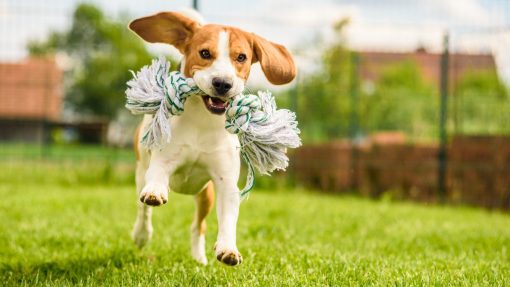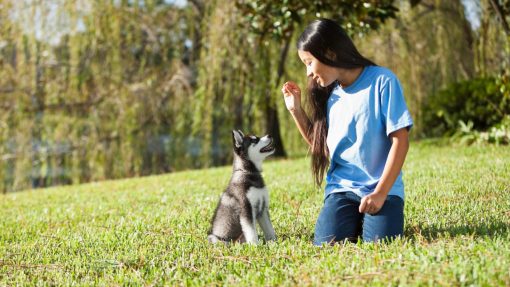Early puppy training is a vital step in raising a well-mannered and confident dog. During the first few months of life, puppies are like sponges, eager to learn and quick to adapt. Introducing basic training during this early stage helps prevent common behavioral issues and sets the tone for a positive lifelong relationship. In this blog, we will discuss how we can approach early puppy training effectively, using gentle guidance, consistency, and positive reinforcement to raise a calm, obedient, and happy companion.
Why Early Puppy Training Matters
Early puppy training is crucial because it takes advantage of your puppy’s most impressionable developmental stage, typically between 8 and 16 weeks of age. During this period, puppies are highly receptive to learning and forming lifelong habits. Introducing training early helps prevent problem behaviors such as excessive barking, biting, or aggression before they become ingrained. It also builds trust between you and your puppy, making future training easier and more effective. Proper early training encourages socialization, teaches boundaries, and helps your puppy feel safe and confident in different environments, ultimately leading to a well-adjusted adult dog.

When to Start Training Your Puppy
Training can begin as early as 7 to 8 weeks old, starting with simple tasks like learning their name, housebreaking, and basic commands. At this stage, training should be fun and rewarding, using short sessions (5-10 minutes) multiple times a day. As the puppy grows, you can gradually increase the complexity of training activities.
Factors to Consider Before Starting Early Puppy Training
Before jumping into training, it’s important to prepare both yourself and your puppy for the process. Early training builds the foundation for future behavior, so setting the right conditions from the start will make learning smoother and more enjoyable for both of you.
Here are some important things to consider:
- Puppy’s Age and Mental Readiness Begin training when your puppy is around 8 weeks old. Keep in mind that young puppies have short attention spans, so training sessions should be kept brief and fun.
- Health and Vaccinations Make sure your puppy has had a basic health check and is up to date on vaccinations before exposing them to new people, places, or group training classes.
- Calm and Safe Environment Choose a quiet and familiar place for training. A peaceful setting helps your puppy focus better without getting overwhelmed by distractions.
- Positive Reinforcement Supplies Have training treats, toys, and a calm tone ready to encourage your puppy during sessions. Using rewards helps build a positive connection with learning.
- Consistency and Patience Stay patient and stick to the same commands and rules. Make sure everyone in the household follows the same approach to avoid confusing the puppy.
5 Basic Commands Every Puppy Should Learn First
Introducing basic commands early in your puppy’s life builds the foundation for a well-behaved and obedient dog. These simple cues are essential for communication, safety, and daily routines. Here’s a closer look at the five most important commands and why each one matters:
- Sit
“Sit” is often the first command puppies learn. It teaches self-control and is useful in many situations, such as greeting people politely, waiting for food, or staying still for grooming. - Stay
The “stay” command encourages your puppy to remain in one place until released. This promotes patience and can prevent accidents, especially in busy or unfamiliar environments. - Come
Teaching your puppy to “come” when called is vital for their safety. Whether they’re off-leash at the park or heading toward danger, a strong recall command can bring them back to you quickly. - Leave It
“Leave it” is a crucial command to stop your puppy from picking up or chewing something harmful, like trash, sharp objects, or toxic food. It teaches them to disengage and look to you for guidance. - Down
The “down” command helps your puppy relax and settle, especially in overstimulating situations. It also establishes you as the leader in a calm and non-threatening way.

Potty Training: Building Good Bathroom Habits
Establish a consistent potty schedule, especially after meals, naps, and playtime. Take your puppy to the same spot each time and reward them immediately after they go. Avoid punishment for accidents—redirect and clean up thoroughly instead. Crate training can support potty training by teaching your puppy to hold it until they’re outside.
Crate Training: Why It’s Useful
A crate provides your puppy with a secure, comfortable space to rest and learn boundaries. Start by making the crate inviting with a blanket and a toy. Gradually increase crate time while you’re home, and never use it as punishment. Proper crate training helps with housebreaking, travel, and reducing separation anxiety.
Socialization
Expose your puppy to various people, sounds, surfaces, and environments during the first few months. Positive experiences with other dogs, strangers, and new places reduce the risk of fear-based behaviors later. Aim for calm, rewarding encounters—never force your puppy into a scary or overwhelming situation.
How to Prevent Bad Behaviors Early
Preventing bad habits in puppies is easier than correcting them later. By setting clear rules, supervising closely, and reinforcing positive actions from the start, you can raise a well-behaved and happy dog. Early training and guidance help your puppy understand what’s expected and build good habits that last a lifetime.
Here are 5 effective ways to prevent bad behaviors early:
- Establish House Rules from the Start
Decide on rules (like no jumping on the couch or begging for food) and stick to them from day one. Consistency across all family members is key. - Supervise and Redirect
Always keep an eye on your puppy, especially during playtime. If they start to bite, chew, or misbehave, calmly redirect them to a toy or proper behavior. - Use Positive Reinforcement
Praise or reward your puppy immediately when they display good behavior—like sitting quietly or chewing on the right toy—to encourage repetition. - Avoid Reinforcing Bad Behavior
Don’t laugh or react to unwanted actions like jumping or barking. Even negative attention can reinforce the behavior. Stay calm and ignore it when appropriate. - Provide Daily Exercise and Mental Stimulation
A tired puppy is a well-behaved puppy. Ensure they get enough physical play, short walks, and brain games to prevent boredom and mischief.
The Role of Positive Reinforcement
Positive reinforcement means rewarding your puppy with treats, praise, or toys when they do something good. This method makes training fun and helps your puppy learn faster. Always give the reward right after the good behavior so your puppy connects the action with the reward. Avoid yelling or punishment, as it can make your puppy scared or confused. Be kind, clear, and consistent to build trust and encourage good behavior.

Long-Term Benefits of Early Puppy Training
Training your puppy from an early age isn’t just about teaching them basic commands; it’s about laying the foundation for a happy, well-adjusted, and confident adult dog. Early training shapes your puppy’s behavior, social skills, and mental health, helping to prevent problems down the road.
Here are 10 long-term benefits of early puppy training:
- Better Behavior in Adulthood
Early training helps puppies learn what’s acceptable and what isn’t. This reduces behavioral issues like excessive barking, jumping, chewing, or aggression as they grow older. - Stronger Human-Dog Bond
Training sessions build trust and communication. This mutual understanding leads to a deeper emotional connection between you and your dog over time. - Improved Socialization Skills
Puppies exposed to different people, environments, and other animals early on tend to be more confident and less fearful in new situations as adults. - Easier Vet Visits and Grooming
Training your puppy to be handled and remain calm makes vet checkups, nail trims, and grooming less stressful for both of you in the long run. - Enhanced Safety
Puppies that learn recall and basic obedience commands like “stay” and “leave it” are less likely to get into dangerous situations, such as running into traffic or ingesting harmful items. - Reduced Anxiety and Stress
Well-trained puppies grow into dogs that are more secure and less prone to anxiety, as they understand routines and expectations. - Better Integration into Family Life
Training early helps your dog adapt to household rules and family routines, making them a well-mannered and welcome member of your home. - More Enjoyable Walks and Public Outings
Dogs that are trained from a young age are more responsive on a leash and better behaved in public, making outdoor activities more enjoyable. - Lower Risk of Rehoming
Behavioral problems are one of the top reasons dogs are given up. Early training reduces these risks, increasing the chances your dog will stay with you for life. - Foundation for Advanced Training
Early obedience makes it easier to teach more advanced tricks, sports, or even therapy dog skills later on, keeping your dog mentally stimulated and engaged.
Conclusion
Starting early puppy training gives your dog the best chance at growing into a calm, confident, and well-behaved companion. By focusing on positive reinforcement, consistency, and patience, you lay the foundation for good behavior and a strong bond that lasts a lifetime. Remember, every puppy learns at their own pace, so stay kind, keep practicing, and enjoy the journey of raising a happy and well-adjusted dog. The effort you put in today will pay off for years to come.

